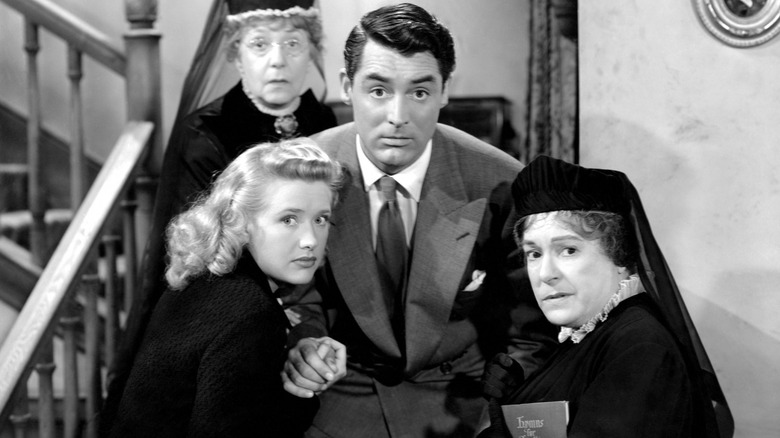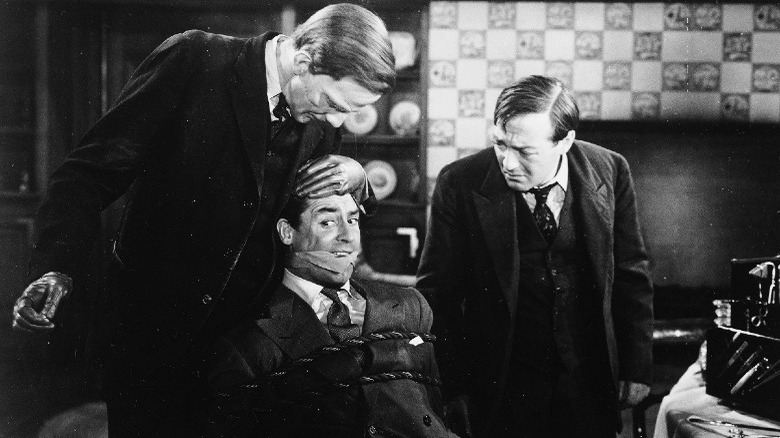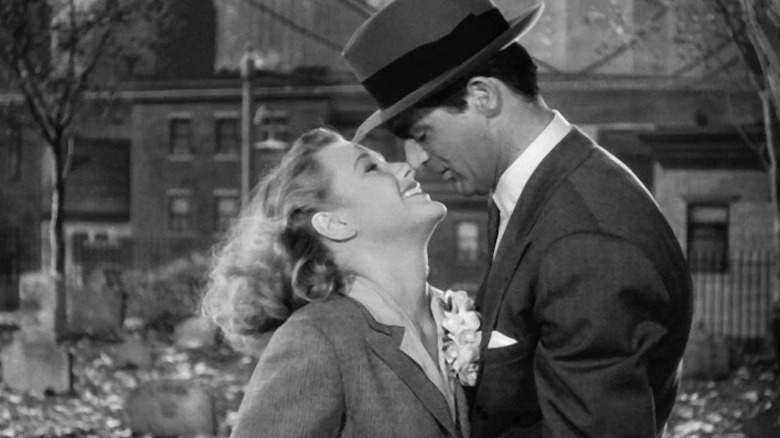Cary Grant Landed His Arsenic And Old Lace Role In An Unusual Way
I came to know playwright Joseph Kesselring's deliciously dark "Arsenic and Old Lace" quite well on accident, much like how its hero, Mortimer Brewster, accidentally stumbles upon his family's homicidal activities. My first exposure came in the form of my sister's high school production of the 1941 play, which was thoroughly entertaining. It was shortly after that I saw director Frank Capra's 1944 film version of Kesselring's farce, with Cary Grant starring as the (naturally) oft-flustered writer Mortimer. In hindsight, this might have also been my gateway to checking out more of Grant's work years later. What can I say? I'm a fan of macabre comedies.
"Arsenic and Old Lace," for all you newcomers out there, centers on the Brewsters, a clan of New Yorkers proudly descended from Mayflower pilgrims. There are Abby and Martha, Mortimer's cheery aunts who raised him and, as he comes to learn, have spent years murdering lonely old bachelors by serving them poisoned elderberry wine (they insist it's all out of the kindness of their hearts). Then there's Teddy, Mortimer's brother, who thinks he's Theodore Roosevelt and spends his days unwittingly digging holes in the family's basement for his aunts' victims, believing them to be them workers who died of yellow fever while digging the Panama Canal. Lastly, there's Jonathan, Mortimer's other brother, a ruthless killer who undergoes plastic surgery to mask his identity, making him look like Boris Karloff (a meta-nod to Karloff originating the role in the play's initial Broadway run).
They are, all in all, a prototypical American family. And Cary Grant's journey to joining this family was a peculiar one.
Warner Bros. wanted a big-time star
In a certain light, "Arsenic and Old Lace" serves as the bridge between Capra's satirical screwball comedies and his aspirational social justice dramedies. Both Capra's film and Kesselring's play portray America as a place that presents itself as the epitome of decency and respectability on the surface but would rather not talk about the many bodies buried in its basement (very literal bodies, in the case of the Brewsters). Who better to play the charismatic lead at the center of this tempest than Grant, who himself divided much of his time as an actor between screwball antics and running for his life in pulpy capers (be they of the Hitchcockian variety or otherwise)?
According to Turner Classic Movies, Capra and Warner Bros. always had their eye on snagging a big-time star to play Mortimer in "Arsenic and Old Lace." Names like Jack Benny and Bob Hope were considered for the role, as was Ronald Reagan (who had signed a multi-year contract with WB in 1937). Casting a real-world super-villain like Reagan would have certainly added a thick layer of irony to a movie about Americans who hide their vile misdeeds and true nature behind an outgoing, folksy facade. Thankfully, WB decided to bring Grant in after receiving widespread criticism for contracting him to star in the film version of another hit play, 1939's "The Man Who Came to Dinner" (fans were adamant the star of the original stage show, Monty Woolley, should reprise his role rather than being replaced by Grant).
Bringing up Baby... er, Grant
In order to convince Grant to swap "The Man Who Came to Dinner" for "Arsenic and Old Lace," Warner Bros. had writers Julius J. Epstein and Philip G. Epstein (the twin brothers who also co-penned a little film called "Casablanca") beef up the role of Mortimer to make him more of a true lead. I recall being aware of this while watching the movie for the first time. In the original play, Mortimer is still the hero but very much part of an ensemble, with his aunts serving as the real stars of the show. This being Hollywood, however, it was the play's male lead who would get more of the spotlight in the big-screen version.
Warner Bros. wound up paying Grant $100,000 to star in "Arsenic and Old Lace," which he donated to the British War Relief fund just as he'd planned to do with his salary for "The Man Who Came to Dinner" (although some accounts claim he was paid $160,000 and pocketed the rest). The movie would go on to become a critical and financial hit, securing a spot on the American Film Institute's list of the 100 funniest American films of all time. Close to 80 years later, it remains an agreeable vehicle for Grant that doubles as a spirited, biting indictment of the myths America presents about itself versus the unsavory truth about its history.
"Arsenic and Old Lace" is available to stream on multiple platforms.


